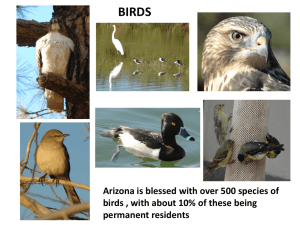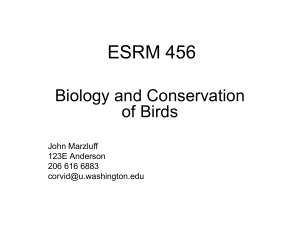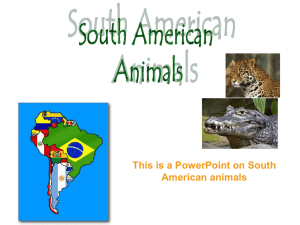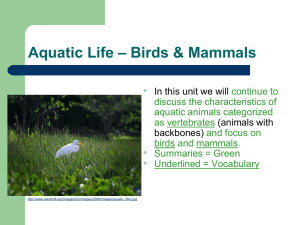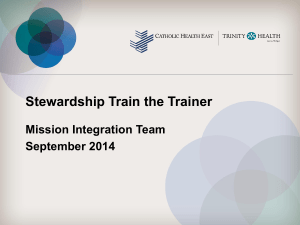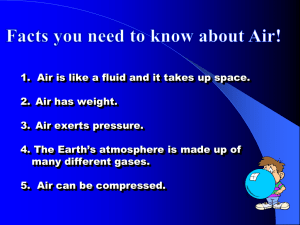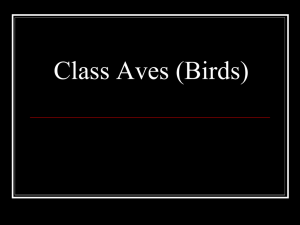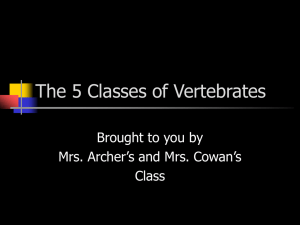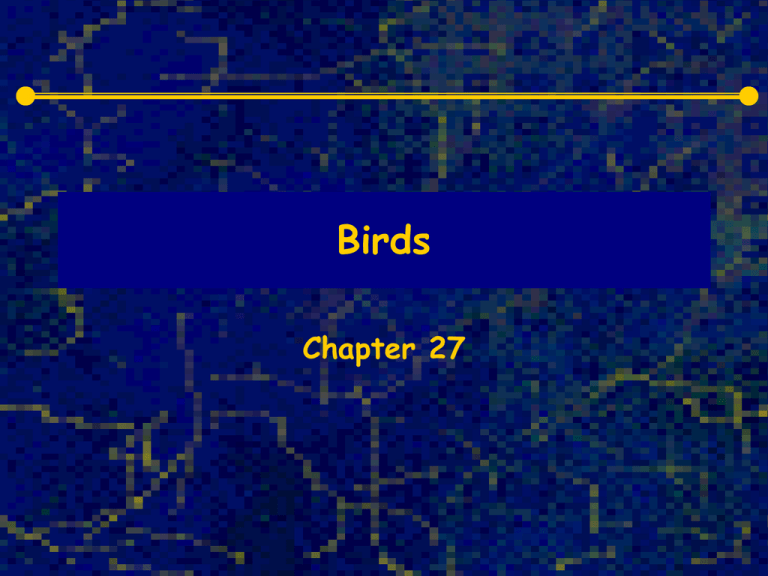
Birds
Chapter 27
I. Diversity
9000 species worldwide; second to fishes in
number of species of the vertebrates
All land biomes; all oceans; both poles
II. Origin
Thomas Huxley recognized that birds share
many characteristics with theropod dinosaurs
Theropods belong to archosaurian diapsid
reptiles (crocodiles are living member)
Similarities with reptiles: 1st neck vertebra
single ball-socket joint, single middle ear
bone (stapes), lower jaw composed of 5-6
bones, excrete waste as uric acid, similar
eggs and development
Fossil Archaeopteryx lithographica has bird
skull with teeth in beak, wings with feathers
but end in reptilian clawed fingers, abdominal
ribs, long bony tail
Archaeopteryx
III. General Characteristics
Feathers unique to birds
Forelimbs wings, but not all capable of flight
Hindlimbs adapted for walking, swimming,
perching
Horny beaks
Lay eggs
Adaptations for flight have created a
uniformity in structure
IV. Feathers
A. Origin
Homologous to reptile scale
Epidermis rolls into cylinder as develops,
forming rachis and barbs
Pigments develop
Rachis and barbs formed from hardened
keratin
Splits out of sheath, feathers protrude
B. Structure
Feather developed to add
more power with less weight
Quill emerges from skin
follicle, becoming rachis as
it extends up feather
Barbs extend from rachis,
each with numerous barbules
spreading laterally
Several hundred barbs form
flat, webbed surface, the
vane of the feather
Neighboring barbs “zip”
together with tiny hooks;
preening keeps barbs
“zipped” and vane surface
intact
C. Types
Contour—outermost feathers forming shape of
bird
Flight—extend off wing in flight
Down—under contour, lack hooks, provide
insulation
Filoplume—hairlike with weak shaft and tufty
barbs
Powder-down—disintegrate and release a
powder that waterproof feathers
Feather Types
Contour
Filoplume
Down
D. Molting
Once a year, usually in
late summer after nesting
season
Gradual process that
avoids leaving bare spots
Flight and tail feathers
are lost in pairs to
maintain balance for
flight
In water birds, takes
place all at once leaving
them grounded for a
period of time
E. Coloration
Lipochromes in feathers give
them red, orange, or yellow
coloration
Melanin colors them black,
brown, red-brown, or grey
Blue color is caused by the
structure of the feather
scattering light
V. Skeleton
Modern birds have
light, delicate bones
with air cavities
(pneumatized bones)
Arching shape of
cavities create
strong bones and
rigid structure
Weight of feathers
may outweigh
skeleton
A. Weight
B. Skull
Evolved from
ancestors with diapsid
skulls
Fused into one piece
Braincase and orbits
are large to hold
larger brain and eyes
Horny beak molded
around bony jaws
Kinetic skull; some
have upper jaw hinged
to skull
C. Vertebral Column and Appendages
Column is rigid with all vertebrae fused except cervical
Additional bony structures called unicate process are
fused to pelvic girdle to provide more rigidity for flight
and support legs (legs are proportionately heavier in
birds than mammals)
Large keel on sternum provides attachment site for
flight muscles
Forelimb bones fused or absent for flight
Muscles in neck provide flexibility
Pectoralis muscles on keel lower
wings
Beneath these,
supracacoracoideus muscles pull
wing up by a “rope and pulley”
system
Having both sets of muscles below
wings provides more flight
stability
Thigh has most muscle mass in leg
Toe-locking mechanism prevents
birds from falling off perch when
asleep
Almost 1000 muscles control tail
feathers for steering
VI. Muscles
VII.Food & Digestion A.Food Sources
Early birds primarily carnivorous, feeding on
insects
Now other animals eaten like worms, molluscs,
crustaceans, fish, frogs, birds, carrion, etc.
1/5 of all birds eat nectar
Other birds eat seeds and fruit
Euryphagous—eats a variety of items and
switches to whatever is in season
Stenophagous—specialize in particular food
source; most vulnerable to extinction
Beaks are adapted to food source
Bird Feet
Feeding
B. Feeding
Fast efficient digestive system provides quick energy
for flight
Birds have high metabolic rate and must eat a
quantity of food; generally the smaller the bird, the
more food it must eat
A hummingbird must eat 100% its own body weight
but a chicken only 3.4%
Taste buds on tongue, salivary glands lubricate food
and tongue
Pharynx, esophagus, crop (some birds produce a
lipid-rich “milk” here), stomach ( 2 parts:
proventriculus secretes gastric juice and gizzard
grinds food), intestines, rectum, cloaca
Some birds swallow grit or pebbles to aid grinding in
gizzard
Bird Anatomy
Bird Digestive System
Bird Beaks
VIII. Circulatory System
Adapted to provide
high oxygen demands
of flight
4-chambered heart
with strong ventricular
walls
Separate pulmonary
and systemic circuits
Heart beat faster as
bird gets smaller:
turkey 93 bts/min;
chickadee 500 bts/min
Active immune system
IX. Respiratory System
Unlike mammal lungs, bronchii do not end in
alveoli but in tube-like parabronchii so that
they can squeeze into available small spaces
in thorax, abdomen, even wing and leg bones!
This system of air sacs provide more
buoyancy and also enables the bird to stay
cool even during flight when 27x more heat is
produced
On inspiration, air flows directly to air sacs,
bypassing lungs; on expiration air flows out
through lungs giving continuous air flow
Most efficient respiratory system of all
vertebrates
Respiratory System
X. Excretory System
Pair of kidneys which filter
blood and resorb some
substances
Urine flows through ureters
to cloaca
Like reptiles, excrete uric
acid to cloaca where water
is resorbed
Marine birds have salt
glands located above each
eye that secrete excess
salts ingested from food
and saltwater; the salt
solution runs out of the
nostrils
XI. Sensory System
A. Brain
Brain has well developed cerebrum, cerebellum, and
hind brain to accommodate requirements for flight
and visual lifestyle
The size of the cerebral hemisphere is directly
related to intelligence of bird; corpus striatum serves
as integrating center rather than the cortex in
mammals
Cerebellum provides sensing for muscle-position,
equilibrium, and vision cues
Optic lobes bulge on either side of midbrain,
providing birds with best vision of all animals
Poor sense of smell except in vultures, flightless
birds, and ducks
Bird Brain
B. Hearing
Excellent hearing
Ear similar to mammals: external ear canal,
eardrum, middle ear, inner ear, cochlea
Hear same range of sounds as humans but not
as high of frequencies; however better able
to distinguish differences in pitch and
intensities
C. Vision
Eye similar to mammals except larger in proportion
to body size
Eye almost immobile; bird turns head instead
Retina with rods and cones; diurnal birds have more
cones; nocturnal have more rods; some birds can see
UV—aids in seeing honey guides on flowers
2 foveae regions of vision give birds excellent
monocular and binocular vision
Vegetarian birds have eyes on sides of head; birds
of prey have them placed in front for better depth
perception
Hawk has 8x better visual acuity than humans and
can see a rabbit 1 km away; an owl can see 10x
better in dim light than human
XII. Flight
A. Evolution
Feathers preceded flight and arose for
thermoregulatory purposes
Flight would provide birds with the ability to
travel to better environments, exploit flying
insects, and provide a means to escape form
predators
Ground-up hypotheses—running birds with
primitive wings to snare insects
Trees-down hypotheses—birds passed from
tree-climbing, leaping, parachuting, gliding
and finally flight
B. Lift
Lift is provided by secondary feathers midarm
Wing is streamlined with concave lower
surface; as air takes longer to flow over the
convex top surface, it creates a negative
pressure generating 2/3 of the lift
Lift/drag ratio determined by tilt and
airspeed: high speeds/small angles or low
speeds/high angles but at 15o stalling will
occur
Slotting in primary feathers can slow down
stalling
Wing Movements
C. Thrust
Besides vertical lift, flight requires forward
thrust
Provided by hand bones with attached primary
feathers; these bend and twist with upstroke
to provide thrust
Upstroke needed for fast, steep takeoffs and
hovering
Greatest power on downstroke
D. Wing Shape
1. Elliptical
Used for flying in
forested habitats
Slotting in primary
feathers prevents
stalling at slow
speeds
High degree of
maneuverability
2. High Speed
Wings sweep back
and taper to slender
tip which reduces
vortex turbulence
Relatively flat and
lack slotting
Seen on birds that
feed while on wing or
make long migrations
3. Soaring Wings
Long narrow shape
without wing slots
Allows high speed,
high lift, and dynamic
soaring
Most efficient but not
very maneuverable
Seen on ocean birds
(albatrosses, gannets,
etc) who can exploit
the sea winds and
wide open spaces
4. High Lift
Broad, slotted wings
allow birds to carry
heavier body mass
and provide sensitive
response to static
soaring
Vultures, hawks,
eagles, owls all have
this wing type
XIII. Migration
A. Reasons
Avoid climatic extremes
Exploit seasonal changes in abundance of food
sources reducing food shortages
Can avoid build-up of specialized predators
Expands living space reducing aggressive
territorial behavior
B. Routes
Lengthening days stimulates pituitary gland to
promote gonad growth, fat deposits, migration, and
even controls courtship, mating behavior, and care of
young
Most follow north-south routes usually in fall and
spring; lanes may be narrow or very broad
Many birds follow landmarks, but some birds fly over
large water bodies
Aquatic species usually make rapid migrations; others
may take months
The artic tern travels from North America to
coastlines of Europe and Africa for the winter,
covering 11,200 miles!
C. Navigation
Chiefly by sight using topographical landmarks
Flocks rely on older experienced birds for
route finding
Earth’s magnetic field
Also use the sun’s position to navigate and tell
time
Use position of stars at night
By natural selection, only best navigators
leave offspring
XIV. Reproduction
Testes are small until breeding season when they may
enlarge 300x; no penis
Fertilization occurs by bringing cloacal surfaces in
contact; must occur in upper oviduct before albumin
and shell added
Left ovary and oviduct develop; right side
degenerates
Glands add albumin (egg white) to eggs as passes
down oviduct; farther down shell membrane, shell,
and shell pigments are also secreted
Sperm may remain alive in oviduct many days after
single mating
Reproductive Organs
Egg Structures
XV. Social Behavior
A. Cooperative
Flocking provides mutual protection from enemies,
greater ease in finding mates, less chance of getting
lost during migration, protection against low
temperatures
Flocking occurs typically in sea birds during nesting
and rearing young; in other land birds it may during
feeding and roosting
Most land birds seek isolation for rearing young
B. Mating
90% of species are monogamous during breeding season
some such as swans and geese, a partner is chosen for
life
Male sings to announce his availability and drive away
other males from territory; female make selection based
on faithfulness and best chance for reproductive success
Both birds care for young
Polygyny most common form of polygamy (1 male mates
with many females); male does not care for young
C. Nesting & Care
Nests may be laid on bare dirt or rocks or may be
made of mud, lichen, brush, grasses; some are made
in hollows and cavities of trees; most are carefully
concealed
Nearly all eggs must be incubated by one or both
parents; usually female does most or all
Most songbird eggs require 14 days to hatch; ducks
may take 1 month
Precocial birds—able to feed, run, swim at birth
Altricial birds—naked and helpless at birth; must be
fed in nest week or more; success of these birds low
(about 20%)
Nesting failure caused by predators, nest parasites
and other factors
Young
Altricial Young
Precocial
Young
Nests
XVI. Populations
A. Fluctuations
Population size varies year to year depending
on abundance of food resources
Bird of prey populations cycle with food
supply
Other birds may relocate to another area to
locate alternative food supplies
B. Declines
Since Dodo went extinct in 1695, more than 80
identified species have gone extinct due to human
influence
Common cause habitat destruction and hunting
Modern hunting techniques have restored wetlands;
no legally hunted birds are endangered
Recent decline of songbirds over last 40 years due
to no fallow agricultural land, fragmentation of
forests, housecats, loss of tropical forests in
wintering grounds, use of pesticides and hunting in
wintering grounds
Introduced species such as sparrows and starlings
can accommodate and are widespread now
XVII. Classification A. Aves
1. Superorder Paleognathe—
modern birds with primitive
archosaurian palate
Ratites—all flightless
Ostriches—Africa
Rheas—South America
Cassowaries, emus—
Australia, New Guinea
Kiwis—New Zealand
Tinamous
Flightless
Central and South
America
2. Superorder Neognathe
Modern birds with
flexible palate
a. Order
Sphenisciformes
Penguins
Wings used for
paddles
Southern oceans
b. Order Pelecaniformes
Fish-eaters with
throat pouch
55 species
worldwide, especially
in tropics
Pelicans, cormorants,
gannets, boobies
c. Ciconiiformes
Long-legged, longnecked waders and
vultures
90 species worldwide
Herons, bitterns,
storks, ibises,
spoonbills,
flamingoes, and
vultures
d. Anseriformes
Broad bills with
filtering ridges
Webbing only on
front toes
Long breast bone
with low keel
150 species
worldwide
Swans, geese, ducks
e. Order Falconiformes
Diurnal birds of prey
Strong fliers with
keen vision
270 species
worldwide
Eagles, hawks,
falcons, condors,
buzzards
Coopers
Red
tailed
Sharp
shinned
f. Order Columbiformes
Short necks, short legs, short slender bill
290 species worldwide
Pigeons and doves
g. Order Psittaciformes
Hinged moveable upper beak with fleshy
tongue
320 species in tropics
Parrots and parakeets
h. Order Strigiformes
Nocturnal predators
with large eyes
Powerful beaks and
feet
Silent flight
135 species worldwide
Owls
i. Order Apodiformes
Small with short legs
and rapid wingbeat
Hummingbirds and
swifts
40 species worldwide
but hummingbirds
mainly found in the
tropics
j. Order Piciformes
Highly specialized bills
Two toes extend forward and two backward
Nest in cavities
380 species worldwide
Woodpeckers, toucans, puffbirds,
honeyguides
K. Order Passeriformes
Perching songbirds
Largest order containing 60% of all bird species
Well developed syrinx (for singing)
Feet adapted for perching on small twigs and thin
stems
Altricial
Singers such as thrushes, warblers, mockingbirds
Nonsingers such as swallows, magpies, crows, jays
5000 species worldwide
l. Order Galliformes
Chicken-like ground-nesting herbivores
Strong beaks and heavy feet
250 species worldwide
Quail, grouse, pheasant, turkey, domestic
fowl

